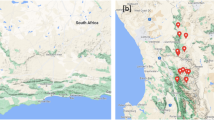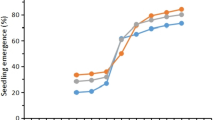Abstract
The Cistus ladanifer L. shrub is a widespread species of the Mediterranean region that is available as a feed source for ruminants all the year round, constituting a source of energy and nutrients when most of the vegetation is dry. However, there is no trustworthy information about the fatty acid composition of C. ladanifer, as well as no information about the seasonal and age related changes in their fatty acid composition. Thus, we collected the aerial parts of C. ladanifer plants of two age groups [young vs. older ones (2–6 years old)] during four consecutive seasons to characterize their fatty acid composition. The fatty acid composition of C. ladanifer is dominated by saturated fatty acids including the occurrence of two methyl branched chain fatty acids (BCFA), the iso-19:0 and iso-21:0, which as far as we know were detected for the first time in shrubs. Also, we demonstrated that several labdane type compounds might interfere with the fatty acid analysis of C. ladanifer. Marked seasonal changes in BCFA and polyunsaturated fatty acids (PUFA) were found, suggesting that BCFA can replace PUFA in plant lipids at high environmental temperatures.




Similar content being viewed by others
Abbreviations
- BCFA:
-
Branched chain fatty acid(s)
- FA:
-
Fatty acid(s)
- FAME:
-
Fatty acid methyl ester(s)
- PUFA:
-
Polyunsaturated fatty acid(s)
- SFA:
-
Saturated fatty acid(s)
References
Teixeira S, Mendes A, Alves A, Santos L (2007) Simultaneous distillation-extraction of high-value volatile compounds from Cistus ladanifer L. Anal Chim Acta 584:439–446. doi:10.1016/j.aca.2006.11.054
Barrajon-Catalan E, Fernandez-Arroyo S, Saura D, Guillen E, Fernandez-Gutierrez A, Segura-Carretero A, Micol V (2010) Cistaceae aqueous extracts containing ellagitannins show antioxidant and antimicrobial capacity, and cytotoxic activity against human cancer cells. Food Chem Toxicol 48:2273–2282. doi:10.1016/j.fct.2010.05.060
Chaves N, Sosa T, Alias JC, Escudero JC (2001) Identification and effects of interaction phytotoxic compounds from exudate of cistus ladanifer leaves. J Chem Ecol 27:611–621. doi:10.1023/A:1010336921853
Ferrandis P, Herranz J, Martinez-Sanchez J (1999) Effect of fire on hard-coated Cistaceae seed banks and its influence on techniques for quantifying seed banks. Plant Ecol 144:103–114. doi:10.1023/A:1009816309061
Dentinho MT, Navas D, Potes J (2005) Chemical and nutritional evaluation of food complements for large cattle breeding, in Montado de Azinho area. Pastagens Forrag 26(27):41–46
Jeronimo E, Alves SP, Dentinho MTP, Martins SV, Prates JAM, Vasta V, Santos-Silva J, Bessa RJB (2010) Effect of grape seed extract, Cistus ladanifer L., and vegetable oil supplementation on fatty acid composition of abomasal digesta and intramuscular fat of lambs. J Agric Food Chem 58:10710–10721. doi:10.1021/jf1021626
Jeronimo E, Alfaia CMM, Alves SP, Dentinho MTP, Prates JAM, Vasta V, Santos-Silva J, Bessa RJB (2012) Effect of dietary grape seed extract and Cistus ladanifer L. in combination with vegetable oil supplementation on lamb meat quality. Meat Sci 92:841–847. doi:10.1016/j.meatsci.2012.07.011
Dentinho MTP, Belo AT, Bessa RJB (2014) Digestion, ruminal fermentation and microbial nitrogen supply in sheep fed soybean meal treated with Cistus ladanifer L. tannins. Small Rumin Res 119:57–64. doi:10.1016/j.smallrumres.2014.02.012
Mariotti JP, Tomi F, Casanova J, Costa J, Bernardini AF (1997) Composition of the essential oil of Cistus ladaniferus L. cultivated in Corsica (France). Flavour Fragr J 12:147–151. doi:10.1002/(SICI)1099-1026(199705)12:3<147::AID-FFJ631>3.0.CO;2-Q
Barros L, Duenas M, Alves CT, Silva S, Henriques M, Santos-Buelga C, Ferreira ICFR (2013) Antifungal activity and detailed chemical characterization of Cistus ladanifer phenolic extracts. Ind Crops Prod 41:41–45. doi:10.1016/j.indcrop.2012.03.038
Chaves N, Escudero JC, Gutierrez Merino C (1997) Quantitative variation of flavonoids among individuals of a Cistus ladanifer population. Biochem Syst Ecol 25:429–435. doi:10.1016/S0305-1978(97)00019-7
Gomes PB, Mata VG, Rodrigues AE (2005) Characterization of the Portuguese-grown Cistus ladanifer essential oil. J Essent Oil Res 17:160–165. doi:10.1080/10412905.2005.9698864
Verdeguer M, Blazquez MA, Boira H (2011) Chemical composition and herbicidal activity of the essential oil from a Cistus ladanifer L. population from Spain. Nat Prod Res 26:1602–1609. doi:10.1080/14786419.2011.592835
Sosa T, Alias JC, Escudero JC, Chaves N (2005) Interpopulational variation in the flavonoid composition of Cistus ladanifer L. exudate. Biochem Syst Ecol 33:353–364. doi:10.1016/j.bse.2004.10.011
Barrajon-Catalan E, Fernandez-Arroyo S, Roldan C, Guillen E, Saura D, Segura-Carretero A, Micol V (2011) A systematic study of the polyphenolic composition of aqueous extracts deriving from several cistus genus species: evolutionary relationship. Phytochem Anal 22:303–312. doi:10.1002/pca.1281
Fernandez-Arroyo S, Barrajon-Catalan E, Micol V, Segura-Carretero A, Fernandez-Gutierrez A (2010) High-performance liquid chromatography with diode array detection coupled to electrospray time-of-flight and ion-trap tandem mass spectrometry to identify phenolic compounds from a Cistus ladanifer aqueous extract. Phytochem Anal 21:307–313. doi:10.1002/pca.1200
Dias LS, Moreira I (2002) Interaction between water soluble and volatile compounds of Cistus ladanifer L. Chemoecology 12:77–82. doi:10.1007/s00049-002-8329-x
Guimaraes R, Barros L, Carvalho AM, Sousa MJ, Morais JS, Ferreira ICFR (2009) Aromatic plants as a source of important phytochemicals: vitamins, sugars and fatty acids in Cistus ladanifer, Cupressus lusitanica and Eucalyptus gunnii leaves. Ind Crops Prod 30:427–430. doi:10.1016/j.indcrop.2009.08.002
Ammar H, Lopez S, Gonzalez JS (2005) Assessment of the digestibility of some Mediterranean shrubs by in vitro techniques. Anim Feed Sci Technol 119:323–331. doi:10.1016/j.anifeedsci.2004.12.013
Sfougaris AI, Nastis AS, Papageorgiou NK (1996) Food resources and quality for the introduced Cretan wild goat or agrimi Capra aegagrus cretica on Atalandi Island, Greece, and implications for ecosystem management. Biol Conserv 78:239–245. doi:10.1016/S0006-3207(96)00054-7
Sukhija PS, Palmquist DL (1988) Rapid method for determination of total fatty acid content and composition of feedstuffs and feces. J Agric Food Chem 36:1202–1206. doi:10.1021/jf00084a019
Palmquist DL, Jenkins TC (2003) Challenges with fats and fatty acid methods. J Anim Sci 81:3250–3254
Enzell CR, Ryhage R (1965) Mass spectrometric studies of diterpenes 1 carbodicyclic diterpenes. Ark Kem 23:367–399
Domenech-Carbo MT, Cruz-Canizares J, Osete-Cortina L, Domenech-Carbo A, David H (2009) Ageing behaviour and analytical characterization of the Jatoba resin collected from Hymenaea stigonocarpa Mart. Int J Mass Spectrom 284:81–92. doi:10.1016/j.ijms.2008.12.015
David JP, Ferrari J, David JM, Guimaraes AG, Lima FWDM, de Souza GLS (2007) New triterpene and antibacterial labdenoic acid derivatives from Moldenhawera nutans. J Brazil Chem Soc 18:1585–1589. doi:10.1590/S0103-50532007000800022
Francisco A, Dentinho MT, Alves SP, Portugal PV, Fernandes F, Sengo S, Jeronimo E, Oliveira MA, Costa P, Sequeira A, Bessa RJB, Santos-Silva J (2015) Growth performance, carcass and meat quality of lambs supplemented with increasing levels of a tanniferous bush (Cistus ladanifer L.) and vegetable oils. Meat Sci 100:275–282. doi:10.1016/j.meatsci.2014.10.014
Guil-Guerrero JL (2014) Common mistakes about fatty acids identification by gas–liquid chromatography. J Food Comp Anal 33:153–154. doi:10.1016/j.jfca.2013.12.006
Ruiz-Lopez N, Sayanova O, Napier JA, Haslam RP (2012) Metabolic engineering of the omega-3 long chain polyunsaturated fatty acid biosynthetic pathway into transgenic plants. J Exp Bot 63:2397–2410. doi:10.1093/jxb/err454
Martins ANC, Simeonov SP, Frija LMT, Viveiros R, Lourenco A, da Silva MS, Casimiro T, Afonso CAM (2014) Isolation, analytical quantification and seasonal variation of labdanolic acid from the Portuguese-grown Cistus ladaniferus. Ind Crop Prod 60:226–232. doi:10.1016/j.indcrop.2014.06.012
Depascualt J, Bellido IS, Basabe P, Marcos IS, Ruano LF, Urones JG (1982) Labdane diterpenoids from Cistus-Ladaniferus. Phytochemistry 21:899–901. doi:10.1016/0031-9422(82)80089-7
Papaefthimiou D, Papanikolaou A, Falara V, Givanoudi S, Kostas S, Kanellis AK (2014) Genus Cistus: a model for exploring labdane-type diterpenes biosynthesis and a natural source of high value products with biological, aromatic and pharmacological properties. Front Chem. doi:10.3389/fchem.2014.00035
Weyerstahl P, Marschall H, Weirauch M, Thefeld K, Surburg H (1998) Constituents of commercial labdanum oil. Flavour Fragr J 13:295–318. doi:10.1002/(SICI)1099-1026(1998090)13:5<295:AID-FFJ751>3.0.CO;2-I
Tsydendambaev VD, Christie WW, Brechany EY, Vereshchagin AG (2004) Identification of unusual fatty acids of four alpine plant species from the Pamirs. Phytochemistry 65:2695–2703. doi:10.1016/j.phytochem.2004.08.021
Radunz A (1987) On the function of methyl-branched chain fatty acids in phospholipids of cell membranes of higher plants. In: Stumpf P, Mudd JB, Nes WD (eds) The metabolism, structure, and function of plant lipids. Springer, New York, pp 197–200. doi:10.1007/978-1-4684-5263-1_34
Arrendale RF, Severson RF, Chortyk OT, Stephenson MG (1988) Isolation and Identification of the wax esters from the cuticular waxes of green tobacco leaf. Beitr Tab 14:67–84
Kroumova AB, Wagner GJ (1999) Mechanisms for elongation in the biosynthesis of fatty acid components of epi-cuticular waxes. Phytochemistry 50:1341–1345. doi:10.1016/S0031-9422(98)00515-9
Vlaeminck B, Fievez V, Cabrita ARJ, Fonseca AJM, Dewhurst RJ (2006) Factors affecting odd- and branched-chain fatty acids in milk: a review. Anim Feed Sci Technol 131:389–417. doi:10.1016/j.anifeedsci.2006.06.017
Kaneda T (1977) Fatty-acids of Genus Bacillus—example of branched-chain preference. Bacteriol Rev 41:391–418
Wongtangtintharn S, Oku H, Iwasaki H, Toda T (2004) Effect of branched-chain fatty acids on fatty acid biosynthesis of human breast cancer cells. J Nutr Sci Vitaminol 50:137–143. doi:10.3177/jnsv.50.137
Ran-Ressler RR, Khailova L, Arganbright KM, Adkins-Rieck CK, Jouni ZE, Koren O, Ley RE, Brenna J, Dvorak B (2011) Branched chain fatty acids reduce the incidence of necrotizing enterocolitis and alter gastrointestinal microbial ecology in a Neonatal Rat model. PLoS ONE 6(12):e29032. doi:10.1371/journal.pone.0029032
Pearcy RW (1978) Effect of growth temperature on the fatty acid composition of the leaf lipids in Atriplex lentiformis (Torr.) Wats. Plant Physiol 61:484–486
Falcone D, Ogas J, Somerville C (2004) Regulation of membrane fatty acid composition by temperature in mutants of Arabidopsis with alterations in membrane lipid composition. BMC Plant Biol 4:17. doi:10.1186/1471-2229-4-17
Glasser F, Doreau M, Maxin G, Baumont R (2013) Fat and fatty acid content and composition of forages: a meta-analysis. Anim Feed Sci Technol 185:19–34. doi:10.1016/j.anifeedsci.2013.06.010
Acknowledgments
The authors would like to thank Fundação para a Ciência e Tecnologia (FCT) through research grants to OG (SFRH/BD/84406/2012), EJ (SFRH/BPD/74527/2010) and SPA (SFRH/BPD/76836/2011) and through the PTDC/CVT/120122/2010 project. We also thank the COMPETE/QREN program for their financial support of the ALENT-09-0140-FEDER000705 project, PRODER program for PRODER-020311015068 project, and to Associação de Defesa do Património de Mértola (ADPM) for kindly supplying the Cistus ladanifer L. samples.
Author information
Authors and Affiliations
Corresponding author
About this article
Cite this article
Guerreiro, O., Alves, S.P., Duarte, M.F. et al. Cistus ladanifer L. Shrub is Rich in Saturated and Branched Chain Fatty Acids and their Concentration Increases in the Mediterranean Dry Season. Lipids 50, 493–501 (2015). https://doi.org/10.1007/s11745-015-4001-4
Received:
Accepted:
Published:
Issue Date:
DOI: https://doi.org/10.1007/s11745-015-4001-4




